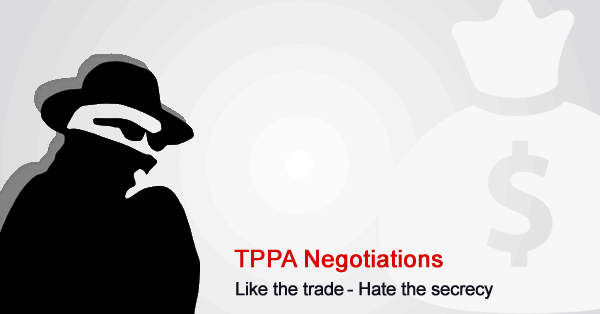Only more evidence that the expectations of those involved in the process continue to be set back – which seems to be the nature of trade negotiations since time immemorial. Our own Minister Tim Groser said last year that “we will cross the finish line in a few months” now that the “ thorny issues such as intellectual property and rules for the textile and apparel trades” have been settled”. Yeah right.
Tim’s been on the perpetual trade negotiation circuit for so many decades now he should know that glacial progress if we’re lucky is the reality and only fools and politicians make predictions about closure. And so it’s been this last couple of weeks where Barack Obama has had to concede more than he’d like in order for the US Senate to accept the idea of only having a yes or no vote on the final TPPA proposal. If the President of the US is still struggling to get his hobbyhorse across the line, what credibility can we ascribe to Tiny Tim’s prognoses of imminent success?
The reality is the TPPA has “only” had 20 rounds since it began in late 2011, which in trade negotiations terms is merely a warming up for the main event. There’s plenty more conferences in far flung exotic destinations to grind through yet.
The scariest thing about this particular deal is the ISDS (Investor State Dispute Settlement). This allows trans national corporates to take elected (and non-elected) governments to a binding disputes resolution arbiter. An altogether new level of power for multinationals this, when you think they would be able to sue for damages to an extent that bankrupts a nation. Fanciful? Hardly when you consider Apple’s cash pile could buy Greece right now, such is the financial differential. More on this issue in the next blog.
Free trade agreements normally have disputes settled by resorting to the WTO, which provides a government-to-government dispute resolution process over the agreements signed under its auspices (mainly those completed under the long distant Uruguay Round of 1986-1994).
As we all know the failure to complete the DOHA round has cast multilateral trade agreements in a bad light, confined them to the “too hard” basket. After decades of experience it’s been concluded that banging that many heads together to get a consensus is just too hard. And, pertinently for New Zealand, it’s protectionism around agriculture that seems to be the main sticking point. Bugger.
And so we’ve had a flush of bilateral arrangements instead – like the recently signed NZ-South Korea deal and before that the NZ-China deal. And now there’s this new lexicon in the world of trade agreements – the emergence of the “polylateral” arrangements such as the TPPA, which involves just 12 countries. Think of it as a coalition of the willing who believe they have enough in common to tear down at least some of the protectionism to enable a win-win-win for all parties.
With the TPPA the main participants are the US and Japan. But of course we’re in there because we want free access to the agricultural markets of these huge economies. So if they’re willing to have us, we absolutely want to be at the table. It’s a huge deal for us – like ridiculously big.
But nothing comes for free New Zealand, so what are you offering at the table? As we noted in our article of March 4th it’s not the trade side of things that is cause for palpations here, rather it’s what the big boys want from us on the investment, regulatory and taxation side that is causing us to gulp. We will look at the worst of these – the Investor State Dispute Settlement – in the next blog. But in short we don’t know much, because the detail of the negotiations is secret.
Therein lies the unusual nature of what’s going on here. This is a deal being hammered out behind closed doors with the strategy being that only once the horse trading is complete will respective parliaments and peoples get to vote on an-all or-nothing, take-it-or-leave-it, final form.
Seems odd, but I can understand why it’s come to this. The perpetual impasse that prevails with other trade deals where every clause is an opportunity for open slather from objectors has demonstrably resulted in little to no progress (bit like global climate change pow wows).
This time around the idea is that we forget multilateralism, and take a smaller bite with a polylateral deal. Sure bilateral deals are even easier – but with 200 countries out there, that’s a hell of a lot of bilateral deals to negotiate. The TPPA requires just a moderate amount of group-think so might be a productive compromise.
That explains the polylateral approach but why the secrecy? Why the determination to produce a “take it or leave it” fait accompli to the participating governments?
The answer to that can only be the fear of those involved in the huddle that public knowledge of what is being horse-traded will spark competing polylateral deals with the result the whole scene descends into a quagmire of inertia – just like multilateral deal-making has.
However, this decision to conduct negotiations in secret provides the conspiracy theorists and the fearful an enormous opportunity to think the worst, to predict the end of the world and more. Vacuums of information encourage exactly that. So the strategy could well bite its protagonists severely on the bum. We will look at the main example of this – the Investor State Dispute Settlement – in the next blog.

